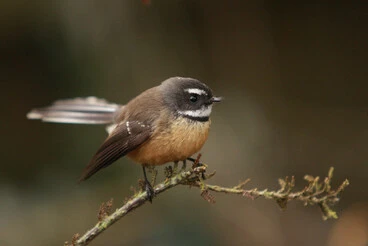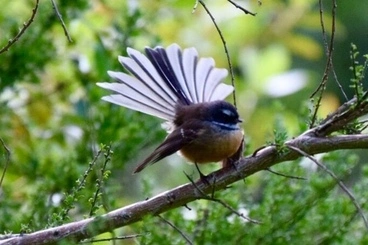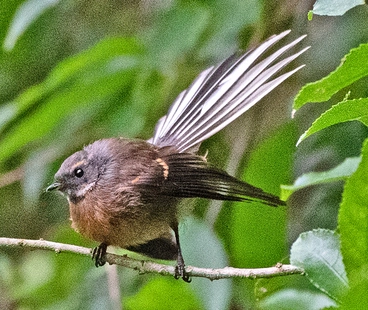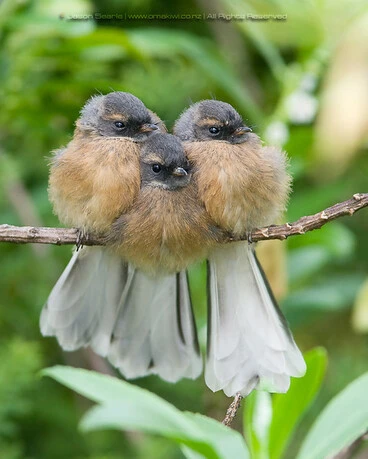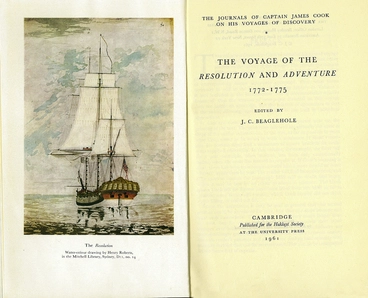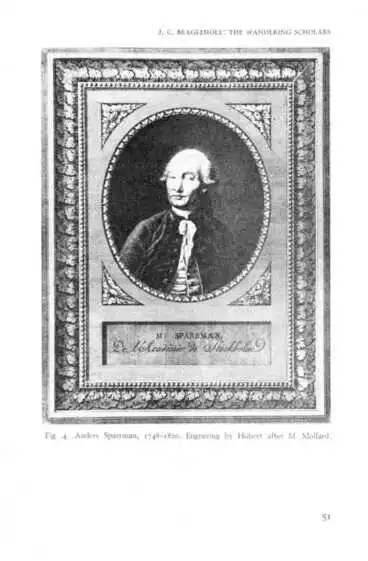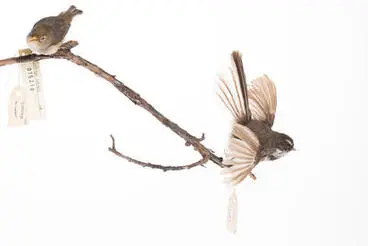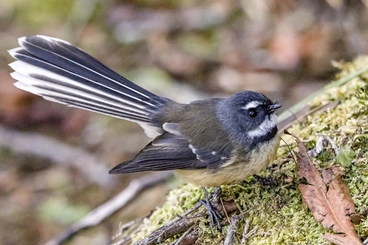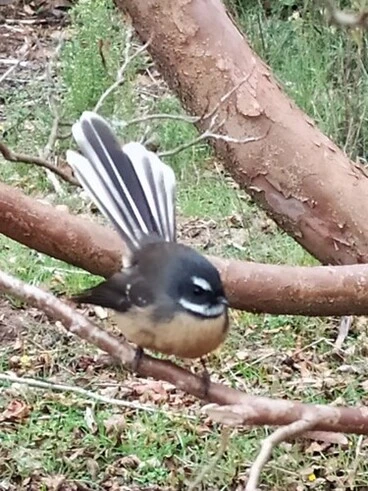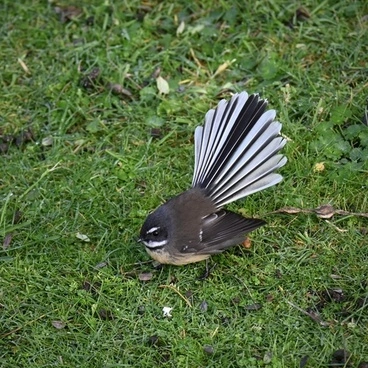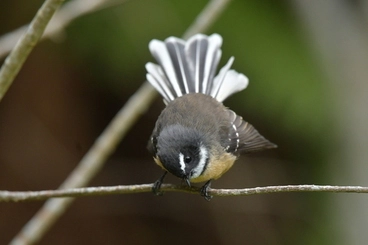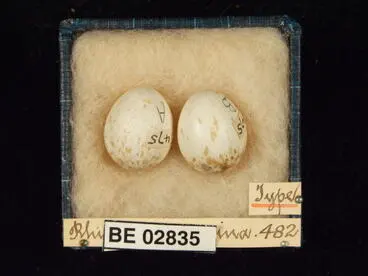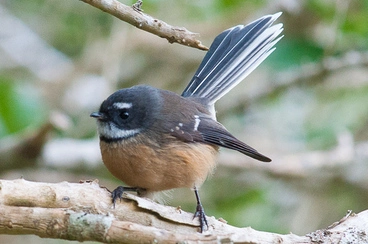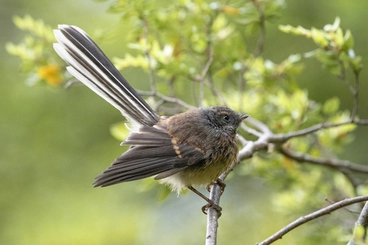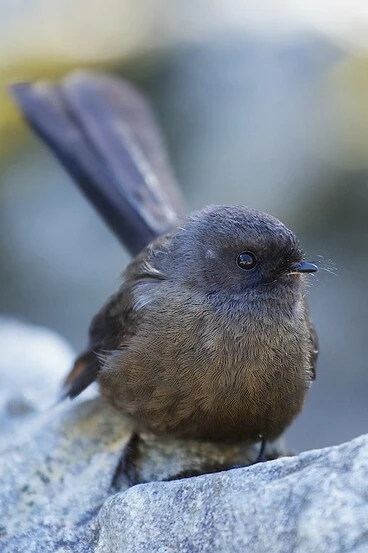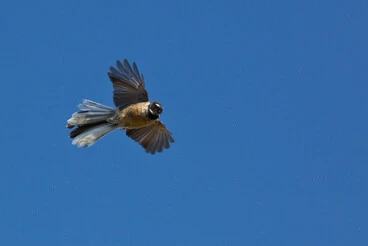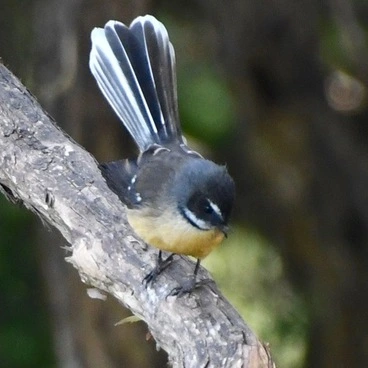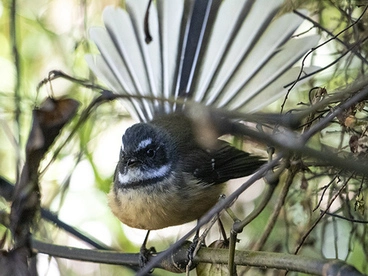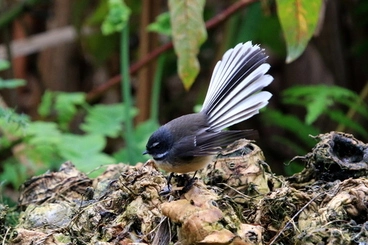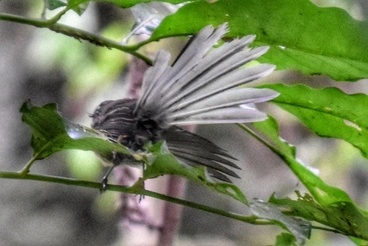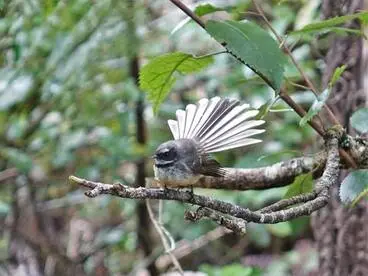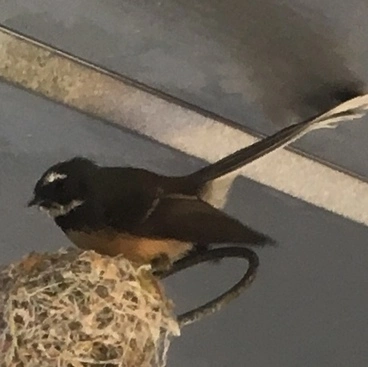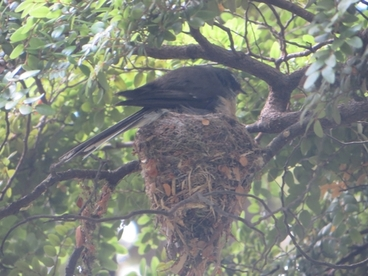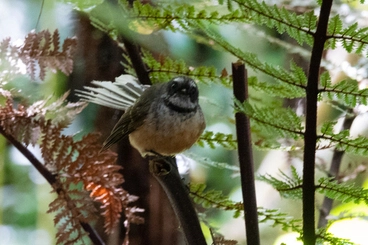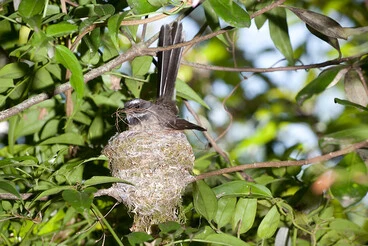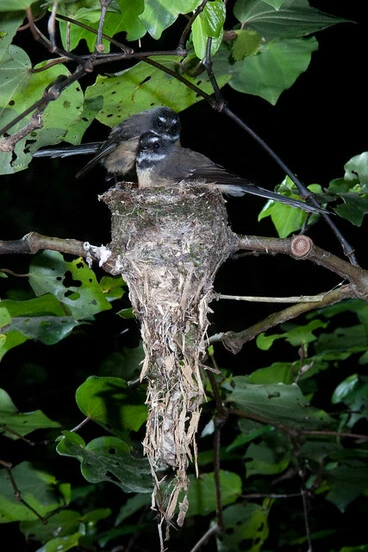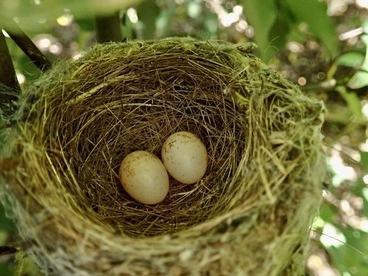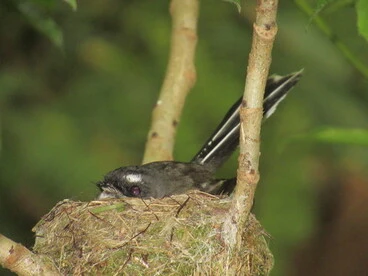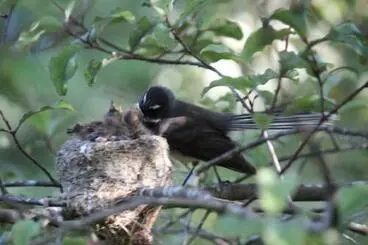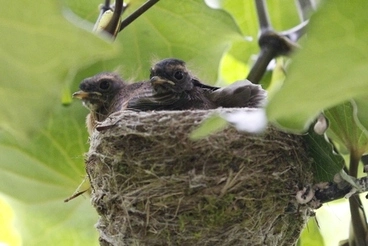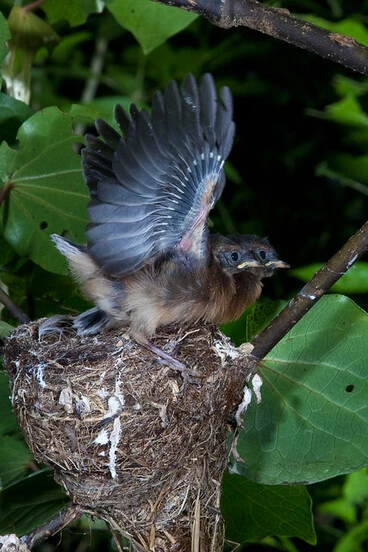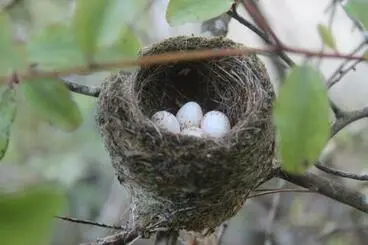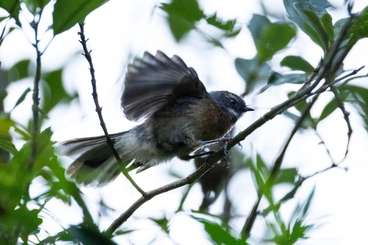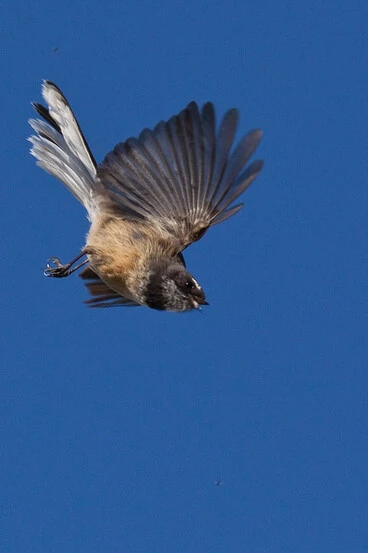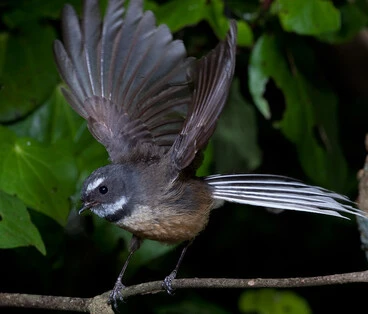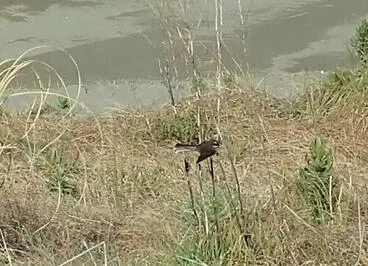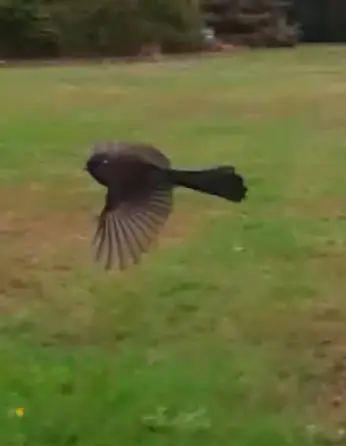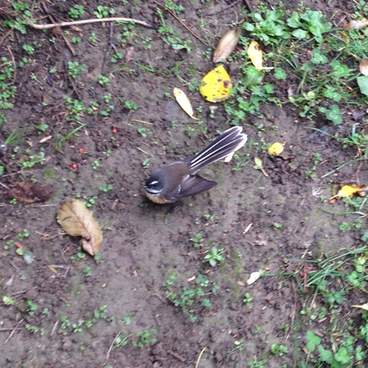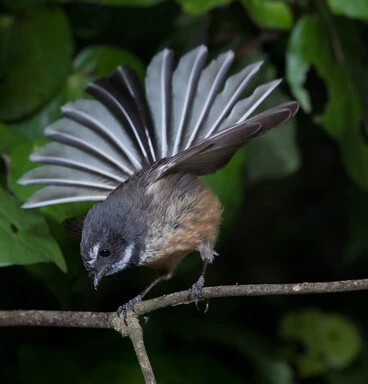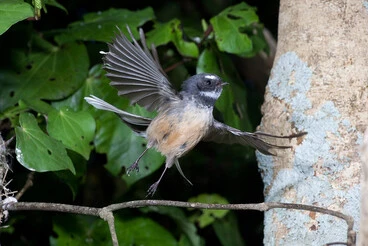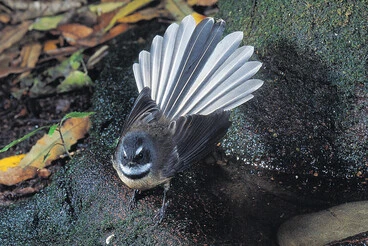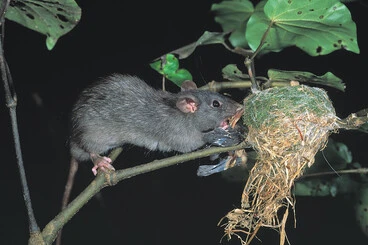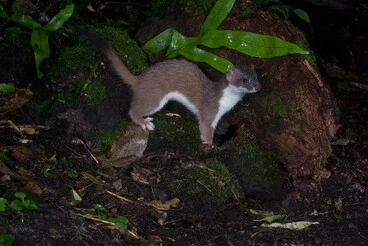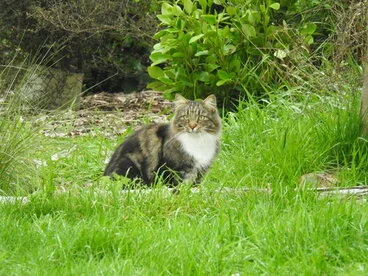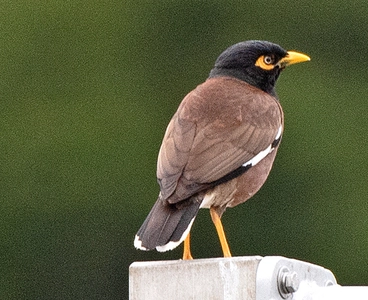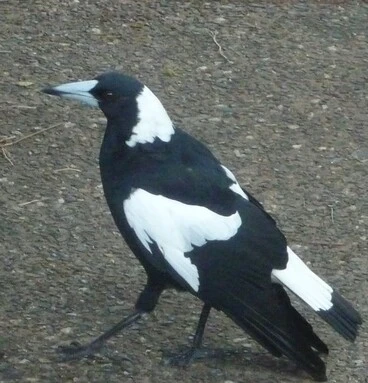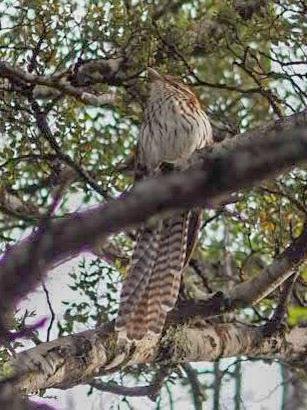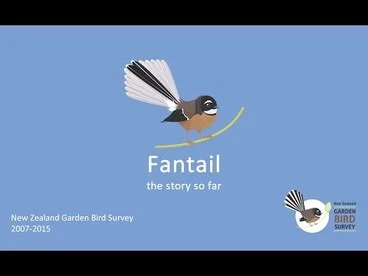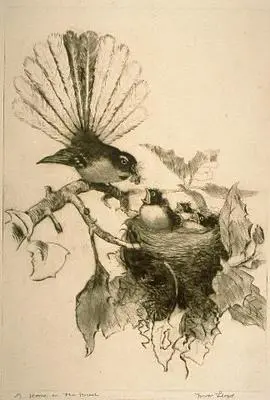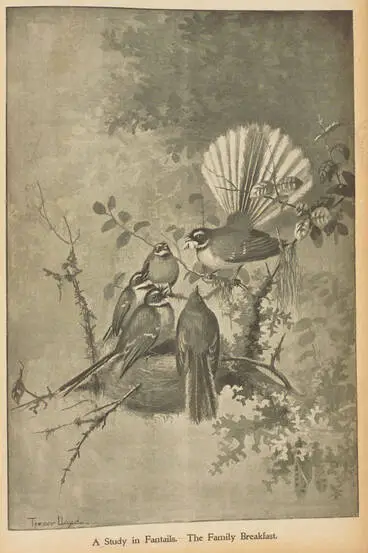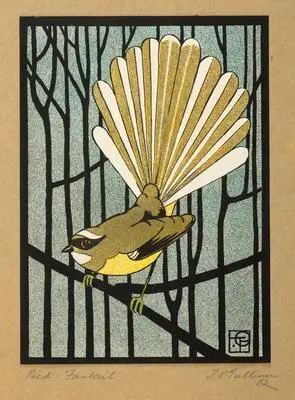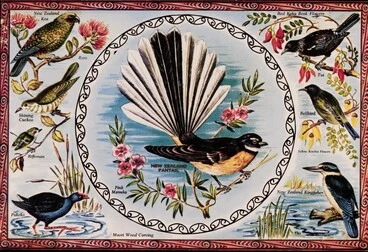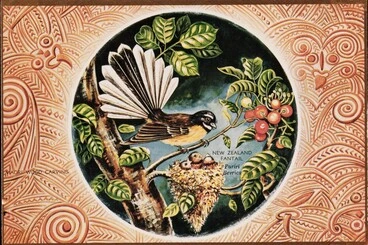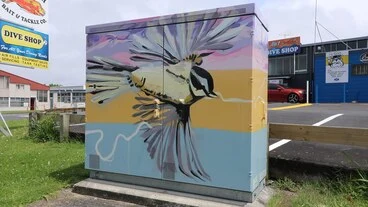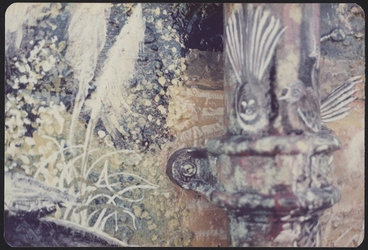New Zealand fantail / Pīwakawaka
A DigitalNZ Story by Zokoroa
A description of the New Zealand fantail - an often seen native bird
The fantail with its distinctive fanned tail and loud twittering vocals is one of New Zealand's most seen native birds. It can be spotted in backyards, parks, orchards, scrubland, native bush, and forests. With its tail spread out like a fan, it hovers from perch to perch on the look out for insects, such as moths, flies, beetles, and spiders; and small fruit. The fantail is also known by its Māori names, of which there are 19 known variants, including pīwakawaka, tīrairaka and pīrairaka. The Chatham Islands / Rēkohu subspecies is known by its Moriori name "Tchitake".
A project was launched in February 2024 to find out more about the natural history of fantails, Landcare Research began tracking fledgling fantails in Hamilton who have left the nest after growing their feathers sufficiently for flying. One aim is to find out how long fantails live as the oldest recorded fantail was 3.5 years of age yet similar fantails in Australia live to 9 years. Another aim is see how far they travel through the Waikato's rural areas and towns, and whether they intermix with fantails in Auckland. The public have been invited to report sightings of fantails which have coloured leg bands. See article in the Piako Post (7 Feb 2024) "Plea to help scientists track fantails"
Fantail
Manatū Taonga, the Ministry for Culture and Heritage
North Island Fantail
iNaturalist NZ — Mātaki Taiao
North Island Fantail
iNaturalist NZ — Mātaki Taiao
Threes a crowd
Manatū Taonga, the Ministry for Culture and Heritage
NZ fantail observed during Captain Cook's voyage in 1773
During 1773, the fantail was observed by the Swedish naturalist Anders Sparrman during Captain James Cook's second voyage to NZ on the ship HMS Resolution.
During 1773, the fantail was observed in NZ by Swedish naturalist Anders Sparrman during Capt Cook's 2d voyage
University of Otago
Fantail classified with flycatchers in genus Muscicapa, 1787
Anders Sparrman included a drawing and description in Museum Carlsonianum (1787, Vol 2, Plate 47) . He classified the bird with the flycatchers in the genus Muscicapa and gave it the binomial name Muscicapa fuliginosa to distinguish between the species of flycatcher birds.
In 1787, Sparrman included a drawing of a fantail & genus description in Museum Carlsonianum, Vol 2, Plate 47
Victoria University of Wellington
The genus 'Muscicapa' was used by others, including John Latham in his "General synopsis of birds", published 1791
Alexander Turnbull Library
Fantails reclassified as Rhipidura, 1827
Since 1827, fantails have been reclassified into the genus Rhipidura by Irish zoologist Nicholas Vigors and American naturalist Thomas Horsfield due to the fan-like structure of the tail. The word 'rhipidura' is from the Ancient Greek: ῥιπίς (rhipís, “fan”) + οὐρά (ourá, “tail”). The rounded shape of the tail at the apex aids the fantail's aerial movements when feeding whereas other birds in the Muscicapa genus have a slightly more forked tail. (See: N. Vigors & T. Horsfield (1826) "A Description of the Australian Birds in the Collection of the Linnenn Society; with an attempt at arranging them according to their natural affinities", Transactions of The Linnean Society of London, (Vol .15, pp. 246-247).
According to the International Ornithologists' Union, the genus Rhipidura has 61 species of fantails in Australasia, Southeast Asia and the Indian subcontinent, as of December 2023. The New Zealand fantail is listed as Rhipidura fuliginosa. (See: Wikipedia: Fantail)
In 1826, fantails reclassified into genus Rhipidura by Nicholas Vigors & Thomas Horsfield as tail more rounded at apex
The word 'rhipidura' is from the Ancient Greek: ῥιπίς (rhipís, “fan”) + οὐρά (ourá, “tail”)
Auckland War Memorial Museum Tāmaki Paenga Hira
The New Zealand fantail's scientifc / binomial name is Rhipidura fuliginosa
1st part of the name identifies the genus to which it belongs & 2d part distinguishes between species of fantails
iNaturalist NZ — Mātaki Taiao
Four subspecies of NZ fantail
There are four subspecies of NZ fantail of which the Lord Howe Island fantail has become extinct.
South Island fantail
Scientific name: Rhipidura fuliginosa fuliginosa (named in 1787 by Anders Sparrman. Conservation status: Not Threatened
iNaturalist NZ — Mātaki Taiao
North Island fantail
Scientific name: Rhipidura fuliginosa placabilis (named in 1921 by Outram Bangs). Conservation status: Not Threatened
iNaturalist NZ — Mātaki Taiao
Chatham Island fantail (Moriori name: Tchitake)
Scientific name: Rhipidura fuliginosa penita (named in 1911 by Bangs). Conservation status: At risk - Naturally Uncommon
iNaturalist NZ — Mātaki Taiao
Lord Howe Island
Scientific name: Rhipidura fuliginosa cervina (named in 1879 by E. P. Ramsay). Conservation status: Extinct
Museums Victoria
Two colour forms or "morphs" of fantail: Pied & Black
Both male and female fantails look alike, though males are slightly larger than females.
Pied fantail - Adult
Greyish head, white eyebrows & upper breast, cinnamon chest & belly, brown back & rump, & white & black tail feathers
iNaturalist NZ — Mātaki Taiao
Pied fantail - Juvenile
Mainly brown tones over the head & body & no white eyebrows, & white & brown tail feathers
iNaturalist NZ — Mātaki Taiao
Black fantail (rare in Nth. Island & less than 5% of fantails in Sth Island)
Mainly black, with black-brown over rump, belly, & flight & tail feathers, & occasionally have white spot over each ear
Manatū Taonga, the Ministry for Culture and Heritage
Flight of the fantail
The 'fan' shape of the tail and the rounded shape of the tail at the apex aids the fantail's aerial movements when feeding on insects, such as moths, flies, beetles and spiders, and on small fruit.
Fantails have small body lengths of about 11.5–21 cm long and have long tails
Fantail/Piwakawaka (Rhipidura fuliginosa).
Nga Manu Nature Reserve
In most fantails, the tail is longer than each wing
South Island Fantail
iNaturalist NZ — Mātaki Taiao
When spread in display or aerial foraging, the tail has a characteristic fan shape
North Island Fantail
iNaturalist NZ — Mātaki Taiao
North Island Fantail
iNaturalist NZ — Mātaki Taiao
North Island Fantail
iNaturalist NZ — Mātaki Taiao
North Island Fantail
iNaturalist NZ — Mātaki Taiao
Listen to the sound of the fantail
Distinctive song has been described as “a chattering tweeta-tweeta-tweeta…. of regular rhythm”, and of high pitch
Radio New Zealand
Breeding
Fantails have a short lifespan with the oldest known fantail living until 3.5 years old
Males may start breeding two months after fledging & stay with their breeding partner for a year
iNaturalist NZ — Mātaki Taiao
In the North Island, fantails nest from August to March
iNaturalist NZ — Mātaki Taiao
In the South Island, fantails nest from September to January
iNaturalist NZ — Mātaki Taiao
On the Chatham Islands, fantails nest from October to January
iNaturalist NZ — Mātaki Taiao
Nest is built of materials such as mosses, dried rotten wood fibres, dried grasses, fern scales; & woven with cobwebs
(Image; Fantail building its nest)
Nga Manu Nature Reserve
Most nests are sheltered from above by foliage
Museum of New Zealand Te Papa Tongarewa
Nests often have a ‘tail’ of material below the base of the nest
Nga Manu Nature Reserve
Two to five eggs are laid by the female & the interval between laying each egg is one day
Egg colour is white with brown spots.
iNaturalist NZ — Mātaki Taiao
Both adults take turns on the nest during incubation which takes about 13-16 days
iNaturalist NZ — Mātaki Taiao
The chicks are fed every 10 minutes for about 11-16 days in the nest
iNaturalist NZ — Mātaki Taiao
Both male & female feed the young chicks in the nest
iNaturalist NZ — Mātaki Taiao
Fantail chicks have short tails and often remain together, often perched side by side
iNaturalist NZ — Mātaki Taiao
Fantail chick will flaps it wings in readiness for leaving the nest
Fantails become independent around 26 - 44 days
Nga Manu Nature Reserve
Two or more broods per season are usually raised in the cup-shaped nests
The male looks after the fledglings when the female starts building the next nest
iNaturalist NZ — Mātaki Taiao
Incubation of the second brood may occur while the fledged young of the first brood are still being fed
iNaturalist NZ — Mātaki Taiao
Methods of hunting for food
Fantails eat small invertebrates such as moths, flies, beetles & spiders; and small fruit
iNaturalist NZ — Mātaki Taiao
Fantail/Piwakawaka (Rhipidura fuliginosa).
Nga Manu Nature Reserve
Hawking method
Fantails use a perch to spot swarms of insects. Then they fly at them & take each one with a snap of its beak & swallow
Nga Manu Nature Reserve
Flushing method
The fantail flies around to disturb vegetation to flush out insects and catch them in flight
iNaturalist NZ — Mātaki Taiao
South Island Fantail
iNaturalist NZ — Mātaki Taiao
Association method - following birds, animals, people (eg trampers) around to capture insects disturbed by movement
They'll join other birds (eg saddlebacks, brown creepers, whiteheads & silvereyes) to forage for food
iNaturalist NZ — Mātaki Taiao
They will also search cracks or crevices in the bark on branches & tree trunks
Nga Manu Nature Reserve
When searching for prey in foliage, fantails often flick their wings & fan their tails
This can frighten any hidden prey into movement which results in them being detected by the fantail
Nga Manu Nature Reserve
During cold weather, fantails can be seen foraging for food on the ground
Nga Manu Nature Reserve
South Island Fantail
iNaturalist NZ — Mātaki Taiao
Predators
Rats will eat eggs, chicks & adults
Nga Manu Nature Reserve
Long-tailed cuckoos frequently raid nests to eat fantail eggs & chicks
iNaturalist NZ — Mātaki Taiao
Annual survey of garden birds
Landcare Research conducts the New Zealand Garden Bird Survey annually between late June & first week of July. Volunteers are asked to choose one day during the survey period and look and listen for birds for one hour; record the highest number of a bird species observed at one time; and submit their results online. Find out more: http://www.gardenbirdsurvey.co.nz
The New Zealand Garden Bird Survey is conducted annually between late June & first week of July by Landcare Research
Video shows findings for fantails recorded by volunteers over one hour periods during 2007-2015
Manaaki Whenua – Landcare Research
Fantail artwork
A Home in the Bush
Auckland Art Gallery Toi o Tāmaki
A study in fantails. The family breakfast
Auckland Libraries
Black fantail and pied fantail
Alexander Turnbull Library
South Island Fantail (Piwakawaka)
Museum of New Zealand Te Papa Tongarewa
Pied Fantail
Auckland Art Gallery Toi o Tāmaki
New Zealand Fantails
Auckland Libraries
New Zealand Fantail
Auckland Libraries
Hamish Allan Painting (4)
UC QuakeStudies
Fantail stamp
Manatū Taonga, the Ministry for Culture and Heritage
"Fantail"
New Zealand Outdoor Art
Whangarei Mural by Chris Wilkie, 1984-5
Auckland Libraries
Fantail sculpture
Kete Horowhenua
Bird sculpture by Paul Dibble
Palmerston North City Library
Street art; corner of Main Street and Pine Avenue; fantail tree.
Upper Hutt City Library
Book 'Fletcher's Adventures' tells history of Upper Hutt through the eyes of the fantail, Fletcher (1996)
Upper Hutt's emblem is the fantail. (Image: Tiffany Lockyer (author) & Jason Attewell (illustrator)
Upper Hutt City Library
Find out more:
Anders Sparrman (1787), Museum Carlsonianum (1Vol 2, Plate 47)
Department of Conservation: Fantail/pīwakawaka, URL https://www.doc.govt.nz/fantail/
N. Vigors & T. Horsfield (1826) "A Description of the Australian Birds in the Collection of the Linnenn Society; with an attempt at arranging them according to their natural affinities", Transactions of The Linnean Society of London, (Vol .15, pp. 246-247).
New Zealand Birds Online: New Zealand fantail | Pīwakawaka, URL: https://nzbirdsonline.org.nz/species/new-zealand-fantail
Piako Post (7 Feb 2024): "Plea to help scientists track fantails", URL: https://www.pressreader.com/new-zealand/piako-post/20240207/281578065558839
Priscilla M. Wehi et al (2019), "Enhancing awareness and adoption of cultural values through use of Māori bird names in science communication and environmental reporting", New Zealand Journal of Ecology, (Vol 43, no. 3: 3387), URL: https://newzealandecology.org/nzje/3387
Ramsay, E. P. (1879), "Description of a new species of Rhipidura, from Lord Howe's Island". Proceedings of the Linnean Society of New South Wales 3: 340, URL: https://archive.org/details/biostor-53831.
This DigitalNZ story was compiled in February 2024
